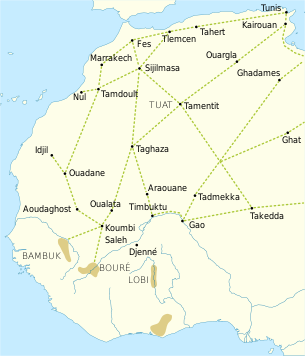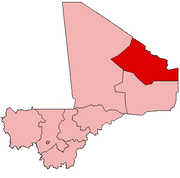| Essouk السوق | |
|---|---|
| Commune and village | |
 | |
| Coordinates: 18°45′N 1°10.5′E / 18.750°N 1.1750°E / 18.750; 1.1750 | |
| Country | |
| Region | Kidal Region |
| Cercle | Kidal Cercle |
| Population | |
| • Total | 2,383 |
| Time zone | UTC+0 (GMT) |

Essouk (Arabic: السوق : "the market") is a commune and small village in the Kidal Region of Mali. The village lies 45 km northwest of Kidal in the Adrar des Ifoghas massif. The ruins of the medieval town of Tadmakka (Arabic: تادمكة) lie 2 km northeast of the present village. Between the 9th and the 15th centuries Tadmekka served as an important entrepôt for the trans-Saharan trade.
The commune is very large in area but sparsely populated. The 2009 census recorded only 2,383 people in an area of approximately 25,000 km. The village of Essouk has only a small permanent population. The rainfall is too low for rain-fed agriculture and almost all the population in the area are nomadic pastoralists.
History
Tadmakka lies some 500 km north-east of Timbuktu in the desert heartland of the Malian Tuareg, and 45 km from the nearest town, Kidal. Its ruins stretch over a kilometre within the Essouk valley. The town prospered between the 9th and 15th centuries as an important entrepôt for caravans—a place where they could prepare for, or recover from, the hardest stretch of the Saharan journey. For caravans travelling south, the town served as the last stopping place before entering the Sudan.
While Timbuktu was almost unknown before the 13th century, Tadmakka was first recorded in Arabic texts in the 10th century, linked to trade with Ghana and Gao, the first historically documented West African states. The earliest mention to Tadmakka is found in Ibn Hawqal's Kitab Surat al-ard ("The Picture of the Earth" ), written in three successive versions between 967 and 988. However the first detailed account of the town was written by the Spanish-Arab historian and geographer al-Bakri in his Book of Routes and Realms which he completed in 1068:
...across the desert plain to Tādmakka, which of all the towns in the world is the one that resembles Mecca the most. Its name means "Mecca-like". It is a large town amidst the mountains and ravines and is better built than Ghāna or Kawkaw . The inhabitants of Tādmakka are Muslim Berbers who veil themselves as Berbers of the desert do. They live on meat as well as on grain which the earth produces without being tilled. Sorghum and other grains are imported for them from the land of the Sūdān.
The Andalusian geographer al-Zuhri, writing in the middle of the 12th century, reported that the Almoravids helped Ghana in a war against Tadmekka in 1083-4 and as a result Tadmekka became Muslim. The historian Nehemia Levtzion pointed out that Tadmekka would have been a Muslim town well before this date and speculated that al-Zuhri may have been referring to the conversion of the population from the Ibadi form of Islam to the more orthodox Maliki school of Sunni Islam. Traders in Tadmekka would have had commercial links with North African towns such as Tahert and Ouargla where there were Ibadi communities.
The medieval town was spread in a north–south direction between two chains of rocky hills that run parallel to each other on either side of a wadi. The main section of the town was on the east bank and extended for 1 km by 200 m. A central section covering an area of 200 m by 100 m was built on a small island while the third section extended for 500 m by 200 m on the west bank. Associated with the town are number of cemeteries. In a cemetery lying to the southwest of the town, tombstones have been discovered that have Arabic epigraphs with 11th century dates. Rock faces on either side of the valley contain petroglyphs as well as inscriptions written using either the kufic or tifinagh scripts. Some of the Arabic inscriptions include 11th century dates.
Archaeological excavations were carried out between January and March in 2005 by a team led by Sam Nixon. Of the three areas of the town investigated, the most complete stratigraphic sequence was obtained at a location opposite the island on the eastern side of the wadi. A 5 m × 5 m (16 ft × 16 ft) area was excavated to a depth of 6.5 m (21 ft) before undisturbed soil was reached. A series of 12 radiometric dates were obtained from carbon containing material. The four samples from the deepest levels produced a range of dates centred on middle of the 8th century while samples from the top levels gave 12th and 14th century dates.
It is sometimes referred to as the "cradle of Tuareg civilization". The annual Saharan Nights festival showcases traditional Tuareg music as well as featuring various world music performers.
Oral tradition holds that Boctou, foundress of Timbuktu, was originally from Essouk. Essouk is also an important archaeological site, featuring rock carvings more than eight thousand years old.
World Heritage Status
The archaeological site was added to the UNESCO World Heritage Tentative List on September 8, 1999, in the Cultural category.
Notes
- ^ Resultats Provisoires RGPH 2009 (Région de Kidal) (PDF) (in French), République de Mali: Institut National de la Statistique, archived from the original (PDF) on 2011-07-22.
- This area is given in the Plan de Securite Alimentaire Commune Rural but appears to be too large. Kidal Cercle covers an area of 25,617 km but precise boundaries have not been established for the three communes within the cercle: Anefif, Essouk and the Urban commune of Kidal. See: Programme de renforcement des capacités nationales pour une gestion stratégique du développement (PRECAGED): Schéma d'aménagement et de développement du Cercle de Kidal (in French), République du Mali: Ministère de l'économie programme des nations unies et des finances, 2002, archived from the original on 2012-03-17, retrieved 2011-08-21.
- Plan de Securite Alimentaire Commune Rurale de Essouk 2007-2011 (PDF) (in French), Commissariat à la Sécurité Alimentaire, République du Mali, USAID-Mali, 2007, archived from the original (PDF) on 2012-05-19.
- ^ Tadmakka. World Archaeology# 39.
- Levtzion 1973, p. 146.
- Levtzion & Hopkins 2000, p. 44
- Holl 2006, p. 8
- Levtzion & Hopkins 2000, p. 65. A translation into French is available online: El-Bekri 1913, p. 339.
- Levtzion & Hopkins 2000, pp. 98–99.
- Levtzion 1973, pp. 45, 136–137.
- Levtzion & Hopkins 2000, pp. 94, 389 note 25.
- Mauny 1961, pp. 487–488. Page 488 has a plan of the ruins.
- ^ Moraes Farias 1990, pp. 91–105.
- Nixon 2009, p. 223.
- Nixon 2009, pp. 231, 236.
- *World Heritage Tentative List: Es-souk (in French), UNESCO – World Heritage Convention, 1999, retrieved 21 Jan 2011.
References
- El-Bekri (1913) , Description de l'Afrique septentrionale (in French), Mac Guckin de Slane, trans. and ed., Algers: A. Jourdan.
- Holl, Augustin (2006), West African Early Towns: Archaeology of Households in Urban Landscapes, Ann Arbor: University of Michigan Press, ISBN 9780915703616
- Levtzion, Nehemia (1973), Ancient Ghana and Mali, London: Methuen, ISBN 0-8419-0431-6. Reprinted by Holmes & Meier in 1980.
- Levtzion, Nehemia; Hopkins, John F.P., eds. (2000) , Corpus of Early Arabic Sources for West Africa, New York: Marcus Weiner Press, ISBN 1-55876-241-8.
- Mauny, Raymond (1961), Tableau géographique de l'ouest africain au moyen age, d'après les sources écrites, la tradition et l'archéologie (in French), Dakar: Institut français d'Afrique Noire, pp. 487–488.
- Moraes Farias, Paulo F. de (1990), "The oldest extant writing of West Africa: medieval epigraphs from Essuk, Saney, and Egef-n-Tawaqqast (Mali)", Journal des Africanistes, 60 (2): 65–113, doi:10.3406/jafr.1990.2452. Link is to a scan on the Persée database that omits some photographs of the epigraphs. Page 90 contains a map of the archaeological site.
- Nixon, Sam (2009), "Excavating Essouk-Tadmakka (Mali): new archaeological investigations of early Islamic trans-Saharan trade", Azania: Archaeological Research in Africa, 44 (2): 217–244, doi:10.1080/00671990903047595, S2CID 163032463.
Further reading
- Moraes Farias, Paulo Fernando de (2010), "Local Landscapes and Constructions of World Space: Medieval Inscriptions, Cognitive Dissonance, and the Course of the Niger", Afriques. Débats, Méthodes et Terrains d'Histoire, 2 (2), doi:10.4000/afriques.896, retrieved 23 Aug 2011.
- Nixon, Sam; Murray, M.A.; Fuller, D.Q. (2011), "Plant use at an early Islamic merchant town in the West African Sahel: the archaeobotany of Essouk-Tadmakka (Mali)", Vegetation History and Archaeobotany, 20 (3): 223–239, doi:10.1007/s00334-010-0279-6, S2CID 140577853.
External links
- Nixon, S., Excavations at Essouk-Tadmakka (Republic of Mali): new archaeological investigations of Early Islamic trans-Saharan trade, University College London, Institute of Archaeology, archived from the original on 2011-10-15, retrieved 2008-10-08.
| Capital: Kidal | ||
| Abeibara Cercle |  | |
| Kidal Cercle | ||
| Tessalit Cercle | ||
| Tin-Essako Cercle | ||